Question: I was intrigued by your example of embodied prayer in your blog article “About Masturbation and Prayer.” Did you get this idea from someplace or did you make it up? There has been a lot of language in spirituality about being naked before God. Has there been a movement to be literal about this rather than metaphorical?
Frank Answers: I made up that prayer suggestion to give the questioner a different way of relating prayer to his “issue.” It was a totally spontaneous response, and I know I went out on a limb. But it didn’t come totally out of nowhere. I’ve been pondering the meaning of the body ever since I had colon cancer and chemotherapy in 2006-2007, including the use of the body in prayer and worship.
The Christian tradition regards body and soul as one. But it has tended to give more attention to the soul than to the body. Thomas Aquinas gave more balance to body and soul than other great theologians because he regarded the two together as one substance and held that each needed the other. The body needed the soul’s intelligence and the soul needed the body’s sensory perceptions. The soul is immortal but immaterial; therefore it needs the body for living expression. In the resurrection body and soul will be united in a spiritual but real body.
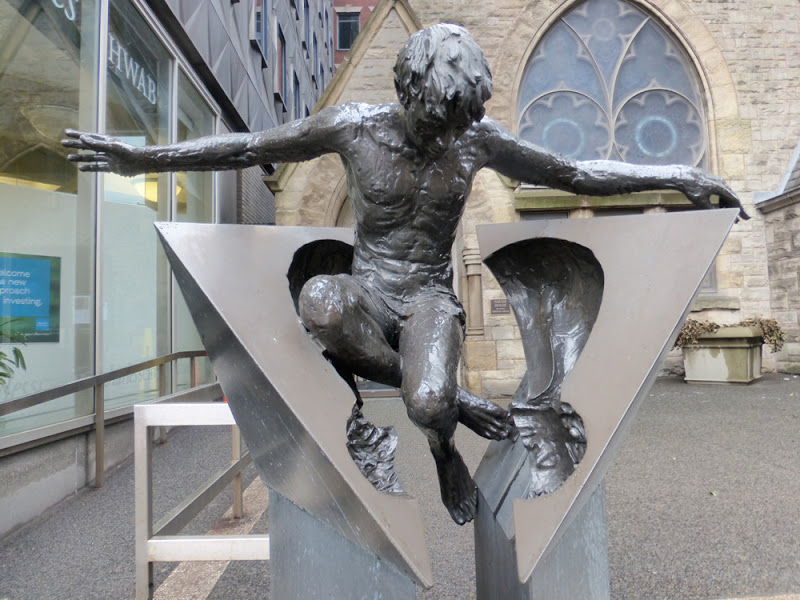
“Resurrection” by Paul Granlund ourside First Lutheran Church, Pittsburgh, PA
My project has been to reclaim the body as the site of God’s interaction with his human creatures. This is the basis of religious ritual and sacramental practice. We talk a lot about the meaning of the sacraments in the abstract. We don’t discuss what it means that the sacraments impact the body.
Too often when we discuss being naked before God, we mean that metaphorically rather than actually. I’ve also come to see that our spirituality as Christians should be as incarnational (in the flesh) as our theology. (See “Frank Answers About the Body — God’s and Ours.”) We need to give more attention to our life of faith in the body. When we’re clothed it’s too easy to ignore the actual body. Clothes place a layer of culture and self-identification over the natural body. When we’re naked we’re more conscious of our body than when we’re clothed, including our bodily relationship to God and to the natural world of which we are a part.
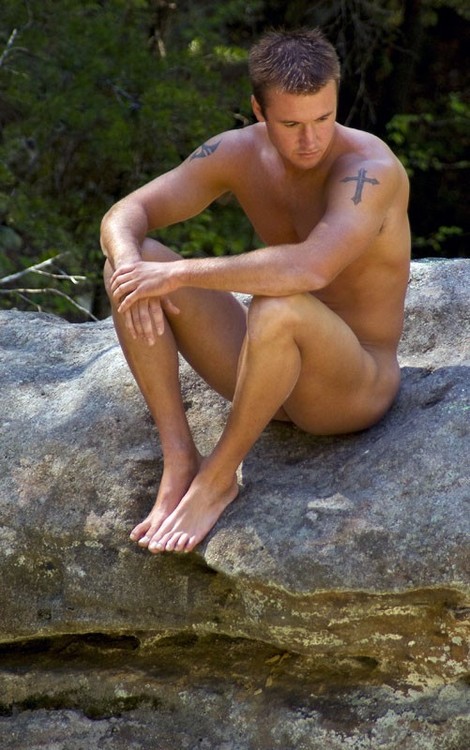
Brian D. McLaren wrote a book entitled Naked Spirituality about being naked before God. But after describing Jesus being stripped of his clothing three times before his crucifixion, and being hung stark naked on the cross, he says: “This is a book about getting naked — not physically, but spiritually. It is about stripping away the symbols and status of public religion—the Sunday dress version people call ‘organized religion’” (p. vii). Actually, I’ve devoted my life to “organized religion” as a pastor of congregations and as a teacher of liturgy and worship. I also think we ought to return to “Sunday dress” to impress upon our minds through our bodies a sense of the importance of what we are doing when we engage in public worship in the presence of the living God. But precisely because the way to the mind is through the body I’ve also given some thought to what it’s like to be physically naked in the presence of that living God before whom “no creature is hidden, but all are naked and laid bare to the eyes of the one to whom we must render an account” (Hebrews 4:13).
The term “naked” is used in spirituality to describe the experience of everything extraneous to the essential nature falling away: all the wanting and grasping, all the fears and struggles. What would life be like if we could relax into our world rather than feeling like we always had to protect ourselves from it? Since what we do with the body influences the mind, maybe being completely and actually naked in prayer would help us have a truly “naked” and liberating experience before God.

One of the things that might keep us from experimenting in nakedness in the presence of God would be negative attitudes toward the body. There’s a significant amount of body shame in our culture. Some people were shamed about their body when they were children or youth by other kids or even by their parents. Maybe they were overweight or small for their age or awkward in coordination in playing sports. Some youth have been sexually abused. Advertisements reinforce our perceptions about what perfect bodies look like and few people measure up to those standards. We become dissatisfied with our bodies. Sometimes it results in eating disorders in which people overeat or starve their bodies in unhealthy ways.
In spite of the ubiquitous presence of nudity in films and on the internet, we Americans are rather prudish when it comes to uncovering our bodies in the presence of others. We lack cultural institutions where it is customary to be naked with family members and even with friends and associates such as in the saunas in Finland and Sweden and the spas in Japan and South Korea.

For all its stress on modesty, Christianity has always affirmed the essential goodness of the human body as God’s creation. Pope John Paul II gave a series of catechetical talks that were collected together as his theology of the body, Male and Female He Created Them: A Theology of the Body, trans. with Introduction by Michael Waldstein (Boston: Pauline Books and Media, 2006). In 1981, as Karol Wojtyla, the future Pope John Paul II expressed the Catholic Church’s attitude to the exposure of the human body in this way in Love and Responsibility (San Francisco: Ignatius Press, 1993):
Because God created it, the human body can remain nude and uncovered and preserve intact its splendor and its beauty… Nakedness as such is not to be equated with physical shamelessness… Immodesty is present only when nakedness plays a negative role with regard to the value of the person…The human body is not in itself shameful… Shamelessness (just like shame and modesty) is a function of the interior of a person.

The legal restrictions on social nakedness in public places has meant that nudity is pretty much associated only with sexuality in our culture in magazines, films, and on the internet. The fact that nudity is associated with illicit behavior and sexual activity could have an impact on our comfort level with being naked before God even in private. Like Adam and Eve, maybe we are still hiding from God “because we are naked.” The Lord God wanted to know, “who told you that you are naked?” Of course, we told ourselves that after eating of the tree of the knowledge of good and evil.
Nakedness in Religion
Nakedness has played an important role in religion. The old yogis were naked warriors and ascetics. In India even today there are Hindu naga sadhus (naked holy men) and Jain “sky clad” ascetics who renounce all worldly encumbrances in order to concentrate on spiritual and eternal things. They go around in a state of nakedness, begging for food from villagers, and bestowing blessings.

There are annual and quadrennial gatherings of thousands, even millions, of Naga Sadhus at the Hindu bathing ceremony of Ardha Kumbh Mela in the Ganges River at Allahabad.

Jainism, which teaches reverence for all living things more than any other religion (including plants, animals, and insects), believes that the soul or jiva can attain liberation from the material world only by subjugating passions and freeing oneself from all attachment to the body and every material possession. This is why monks following the Digambara (sky clad) sect of Jainism do not wear any clothes at all, whereas the Shwetambaras (white clad) wear minimal, unstitched white clothes. The Jain monks, unlike the Hindu naga sadhus, also shave their hair and often their beards. Since women cannot be naked in public, Digambara Jains believe that women have to be reborn as men before they can achieve total salvation. So women renunciates in both the sects wear white clothes that cover their bodies completely.

Naked yoga classes have been springing up in cities across America and in other parts of the world which provide some experience of social nudity in an activity that has a spiritual dimension.

Most yogins might be reluctant to experience that. But in the privacy of their homes, yogins might practice with less on. I’ve sometimes practiced yoga in the early morning just my pajama bottoms or briefs. My yoga practice includes meditation at the end of asana practice. I’ve tried sitting naked in meditation to experience what it is like. It’s only one step further to move from meditation to prayer. When I once had a friend to sit in meditation with in the morning we did include verbal prayer at the end of our sit and on occasion I was naked.
(See “Frank Answers About Naked Meditation.”)
I’ve often thought about those meditating and praying holy men in India who were naked before God and I’ve wondered if there might be a powerful spiritual experience in that practice that I’ve been missing. With the example of the naga sadhus, as well as a number of biblical references, the idea for naked prayer came to me when I answered the young man’s question about masturbation and the life of prayer. (See “Frank Answers About Masturbation and Prayer.”) Let me line up references from the Bible and from church history to see what these examples might suggest.
Nakedness in the Bible
Certainly the Jewish and Christian traditions have promoted modesty in public dress. But the theme of being naked before God takes us back to the beginning of the Bible. In Genesis 2:25 we learn that “the man and his wife were both naked and were not ashamed.” (The image above this article is The Temptation and Fall of Adam and Eve from the ceiling of the Sistine Chapel by Michelangelo.) The immediate effect of the sin of disobedience for both Adam and Eve is that they became aware of their nakedness and were ashamed. The result is an attempt to hide their nakedness—certainly from God, but also from each other. Note in this story where they considered themselves naked. They covered the loin area with aprons made of leaves.

Contrary to all the paintings of Adam and Eve in which Eve’s breasts are covered with her hair or a tree branch, Eve does not also fashion a bra. The loin is the area where sex occurs, where our deepest relationship with each other is expressed. Sin broke their relationships with God and with each other and that’s why they covered the genital area. But the Lord God in his grace made clothing of animal skins for Adam and Eve when they were expelled from the Garden of Eden. Modesty was not what God imposed in the beginning; it was a concession to human shame in the situation of the “fall.”
Nakedness shows up a lot in the Bible and usually at important moments. Jacob wrestled through the night with the angel—probably naked, since that’s how men wrestled in antiquity—and received a name change to “Israel” (meaning “one who struggles with God”).
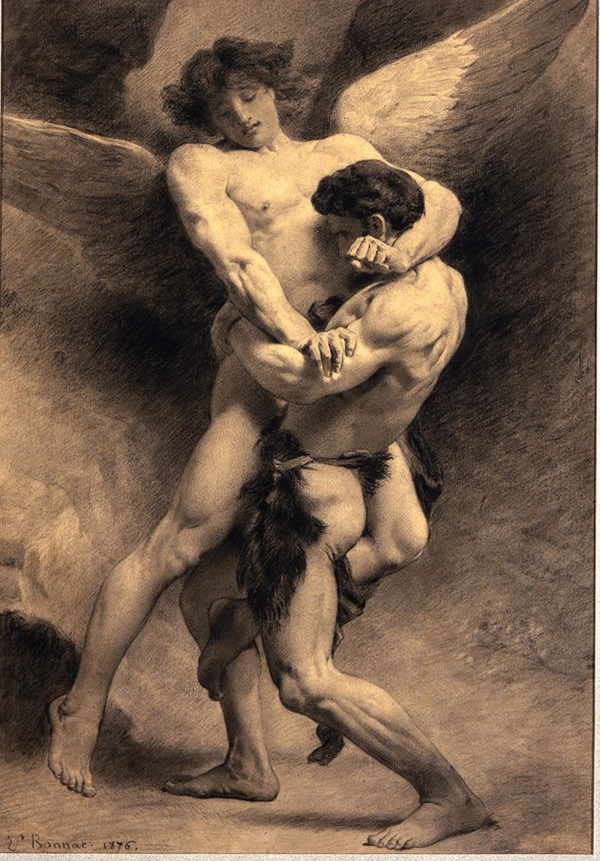
Perhaps most famously in the Old Testament, David danced naked before the ark of the Lord when he brought it up triumphantly to Jerusalem wearing only a linen ephod (a simple apron), which didn’t leave much to the imagination as he leaped and danced, to his wife Michal’s chagrin (2 Samuel 6:12-16).

The record for the longest stint of going naked belongs to the prophet Isaiah. He received an order from God to remove his sackcloth and strip himself naked to the point of baring his rear end (buttocks) and to also walk completely barefoot, essentially going stark naked for three years (Isaiah 20:2-4) as a shocking display to warn the Egyptians and the Cushites of the impending doom that shall befall them when they too shall have to be stripped completely naked from top to bottom. Isaiah’s demonstration was intentionally shameful because he was foretelling the shaming of the Egyptians and Cushites.

In the passion narrative in the Gospel of Mark a young man who had been at the baths comes out into the Garden of Gethsemane at the commotion of soldiers who had come to arrest Jesus and drops his towel as he runs off naked into the night. This piece of information which does not essential to the narrative, suggests, in a tightly written gospel, that it was considered important to the evangelist. Presumably this is the same young man who shows up in the empty tomb wearing a white robe and announcing to the myrrh-bearing women that Jesus is risen and is going ahead of them to Galilee.

Of course, Christ himself was naked in the most important events of his life: his birth; his baptism by John in the Jordan River (he is pictured as naked in the water in an early Eastern icon); his suffering (flogging) under Pontius Pilate; his crucifixion; and his resurrection. Artists have portrayed Christ nude or mostly nude in all of these events.

The most consequential example of Christ being naked before God and the world is his crucifixion. Out of concern for modesty, paintings of Christ’s crucifixion usually have some sort of cloth loosely draped around the loins. But Roman crucifixion was meant to be publicly humiliating and the victims were hoisted naked on the stile for all to see. Their genitals were not sedately covered with a loin cloth. In Roman-style crucifixions, the feet were not resting on a block. Rather, the crucified were seated on an extended rod called the sedile that jutted straight out of the upright post and went between their legs. It wasn’t supposed to be comfortable. And, yes, as they moved back and forth on that rod erections undoubtedly occurred.
Renaissance artists such as Peter Paul Rubens and Anton Van Dyke went as far as they could in showing the genitals of Christ, which art critic Leo Steinberg opined was suggested by the bunched up loin cloth at the location of the penis. Modern artists have been bolder in painting a full frontal naked Christ. Female artist Amber Cobelle painted a nude portrayal of the crucified Christ in a Renaissance style.
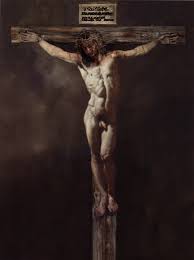
Films like Martin Scorcese’s The Last Temptation of Christ (with Willem Dafoe as the nude Christ on the cross) and the Canadian Jesus of Montreal tried to present a historically accurate form of the crucifixion showed a naked Christ but with the genitals discreeted hidden between the legs which were twisted sideways. Gay Italian artist Vittorio Carvelli was very interested in the eroticism of crucifixion scenes. In his painting of the Crucifixion showed the genitals of the three crucified figures. In another version of this painting Jesus is speared and the two thieves have erections, but not Jesus. (See Frank Answers About Crucifixion Erections.)
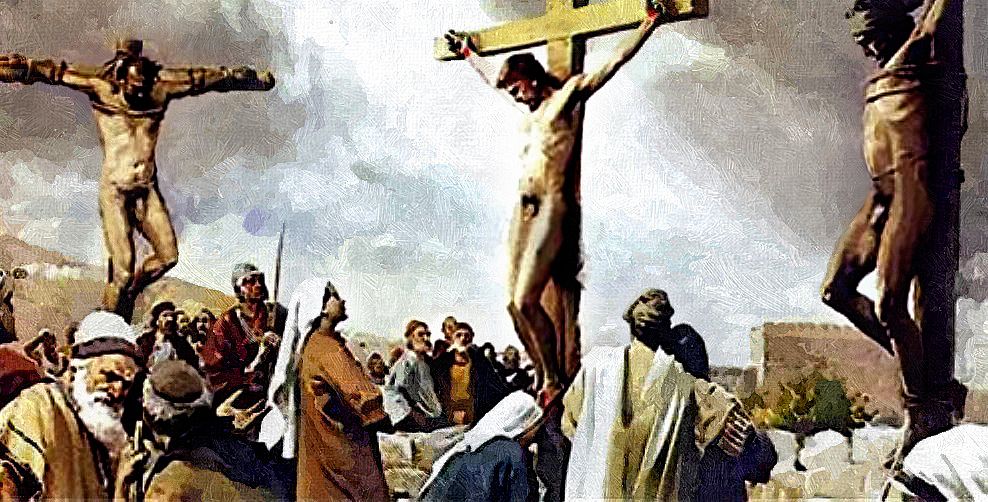
Ralph Alsbach presents a revisionist portrayal of the crucifixion that aims at realism. The artist explains: “The Romans, the great masters of intimidation, always stripped crucifixion victims completely naked, and usually hung them with a cross beam on an existing tree when they could because it was easier. I imagined the two thieves hung on the same tree and an angry Mary because what mother wouldn’t be angry. Jerusalem is in the backround, though I simplified the walls and gate. Jesus is shown as a Hebrew man, with normal hair & beard type & length for the time, normal skin color for people of this region at the time, especially for a man who spent most of his time outdoors, and was nearly covered in blood.”
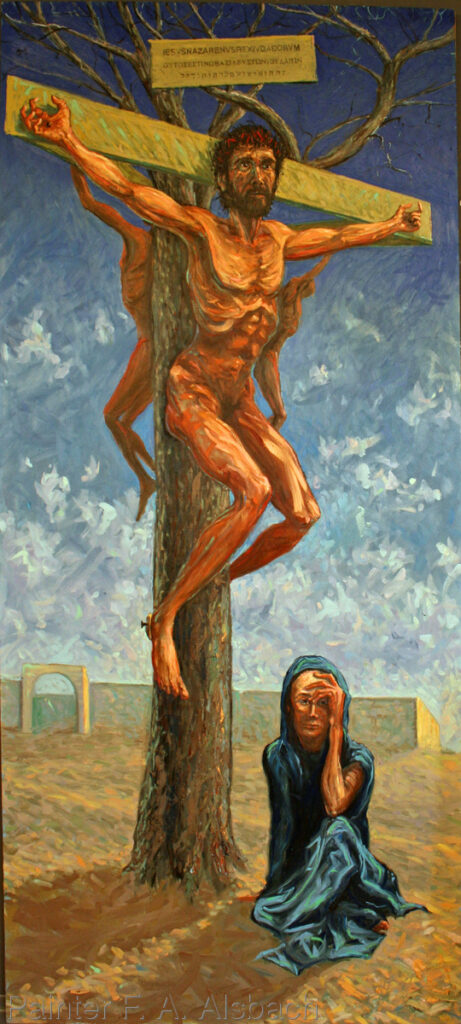
For Christians our crucified Savior was raised up on a public pole naked before God and before the world. Here was the New Adam in a radical act of obedience to God naked and without shame. The crucified naked Christ is a model for how we stand before the Lord who created us.
Christ was crucified and died. Paintings of lamentation show the faithful women and male disciples wrapping the body of Jesus in the burial linen. This painting by Ludovico Carracci (1582) is especially realistic in its details and reactions of the participants.
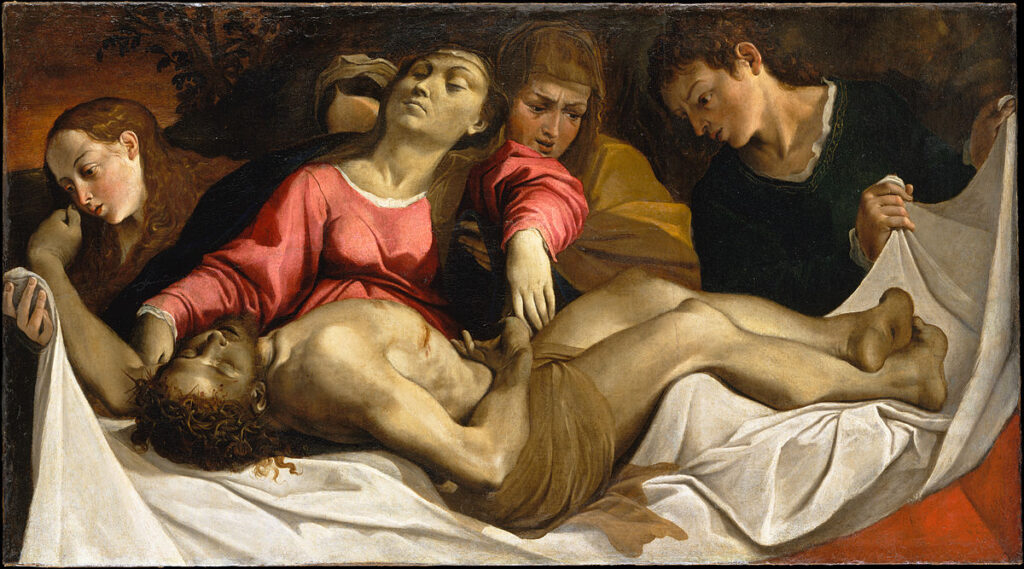
The risen Christ must have emerged from the tomb naked because the grave clothes were found by the apostles Peter and John rolled up in a heap. Michelangelo portrayed this in his sculpture of the risen Christ in his original sculpture, but a 17th century pope insisted on having Christ’s genitals draped with a bronze “cloth” that doesn’t seem supported by anything (the suggestion is that it is falling off). This contemporary painting of Christ’s resurrection by German artist Michael Triegel portrays Jesus rising from the tomb leaving the grave clothes behind and with gentials uncovered. The myrrh-bearng women and the sleeping guard are included in the scene.

Resurrection scene by Michael Triegel
This painting by Gay Mormon writer and artist Dirk Vanden shows Jesus jumping for joy after the resurrection, although it also suggests Jesus’ ascension. But in the Gospel of John resurrection and ascension belong together.

Could we imagine the naked risen Christ ascending to heaven in the same state as he was in his resurrection? In the Acts of the Apostles 1:11, two men in white robes told the apostles, “This Jesus, who has been taken up from you into heaven, will come in the same way as you saw him go into heaven.” Michelangelo painted Christ nude in the mural of “The Last Judgment” above the altar in the Sistine Chapel, as well as the saints coming with him and and dead rising as all naked. A later pope caused some of the nude bodies to be covered with loin cloths, including Christ.

The Body Naked before God and the world in Church History
In imitation of the passion of Christ early Christians went to their martyrdoms, enduring public exposure and gruesome tortures naked and unashamed. The martyrdom probably most frequently depicted in art is that of St. Sebastian, the army captain who was executed by archers on orders from Emperor Diocletian for showing sympathy to Christians.
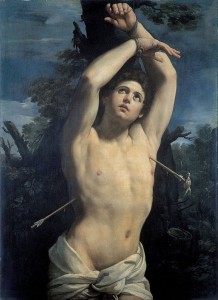
Actually, Sebastian’s martyrdom was quite humane in comparison with those of other Christians, probably owing to his standing in the Roman Legion. (The legend of St. Sebastian tells that he actually survived, was nursed back to health, and went back to witness to the Emperor Diocletian and was beaten to death.) The most famous example of Roman torture of Christians was feeding them to the lions and other beasts in the arena.

The remarkable thing about the Christian martyrs was how calm they remained instead of screaming in pain, and how they preached to their tormentors instead of cursing them. By the witness of their bodies they upended the Roman approach to torture.
The body naked and mutilated before God and the world was the primary witness of Christian martyrs. When the age of persecution came to an end, Christian ascetics continued the witness of the suffering body with abstinence from sex and food and a rejection of creature comforts such as clothing and shelter

The raw asceticism of the desert fathers was moderated and regulated in the organization of monasticism. Later in church history there is the celebrated story of young Francis of Assisi removing his clothes and standing naked before his father and his father’s friends and associates to renounce the wealth that had been his birthright.

Perhaps picking up on this dramatic action a later Franciscan credo became nudus nudum Christum sequi (“follow naked the naked Christ”). It was a radical call to cast aside worldly wealth and belongings and acknowledge the fragile, fallen nature of all men and women. Influenced by this Franciscan spirituality, late medieval painters portrayed Christ naked at his birth (with his penis showing) with Mary nursing the child (with her exposed breast) as well as Christ almost naked at his crucifixion and resurrection.

Nakedness in Baptism
For all Christians the body is impacted by the sacraments of Christ administered by the church. Baptism is basically a bathing and anointing of the body. The ancient Christians practiced naked baptism. In his Homilies on the Sacraments (Mystagogical Catecheses) Cyril of Jerusalem commented on how the candidates went naked into the waters and were not ashamed.
Upon entering [the baptistery] you took off your clothing, and this symbolized your stripping off of “the old nature with its practices.” Stripped naked, in this too you were imitating Christ naked on the cross, who in his darkness “disarmed the principalities and powers” and on the wood of the cross publicly “triumphed over them.” Since hostile powers lurked in your limbs, you can no longer wear your former clothing; I do not of course refer to visible apparel but to “your old nature which is corrupt through deceitful lusts.” I pray that the soul which has once thrown off that old nature may never resume it, but rather speak the words of Christ’s bride in the Song of Songs: “I had put off my garment; how could I put it on?” This was a remarkable occasion, for you stood naked in the sight of all and you were not ashamed. You truly mirrored our first-created parent Adam, who stood naked in Paradise and was not ashamed.
Granted that people were more used to being naked in the public baths than we are today, Cyril’s theological point was that baptism effects a new creation. Paradise is restored. If sin is about being ashamed before God and others, baptism makes one unashamed to be naked before God and others. Clothing serves to conceal shame. At the most important moment of Christian life—our baptism—we are (or were once upon a time) naked before God.

The Orthodox Church continues to baptize adults at least partially naked; they may wear bathing suits, underwear, or a simple white covering. Babies are baptized naked with full immersion, as in this Russian Orthodox baptism.

Nakedness in Prayer
Where does that leave us? I’m not aware of any movements toward naked prayer among Christians. Certainly in public, realizing the fallen human condition, modesty must be preserved. But in private, when alone with God, we might present ourselves naked in the presence of the Holy One. Naked meditation and prayer invites us to be vulnerable and open to the possibility of transformation by being in the presence of God with no barriers. (For reasons of comfort this may not be for everybody.)
Believing that the God who created, redeemed, and sanctifies you accepts you as his child, in the privacy of your own place of Bible reading, meditation, and prayer (most likely in your home), you might try just being in the presence of God completely naked. Being naked in God’s presence might prove or reinforce what you honestly believe about yourself and your relationship to God.
I offer here a simple morning prayer office in which one might pray naked upon arising in the morning. The attitudes of prayer can be embodied through the use of different postures.
Embodied Prayer Form: Order for Morning Prayer
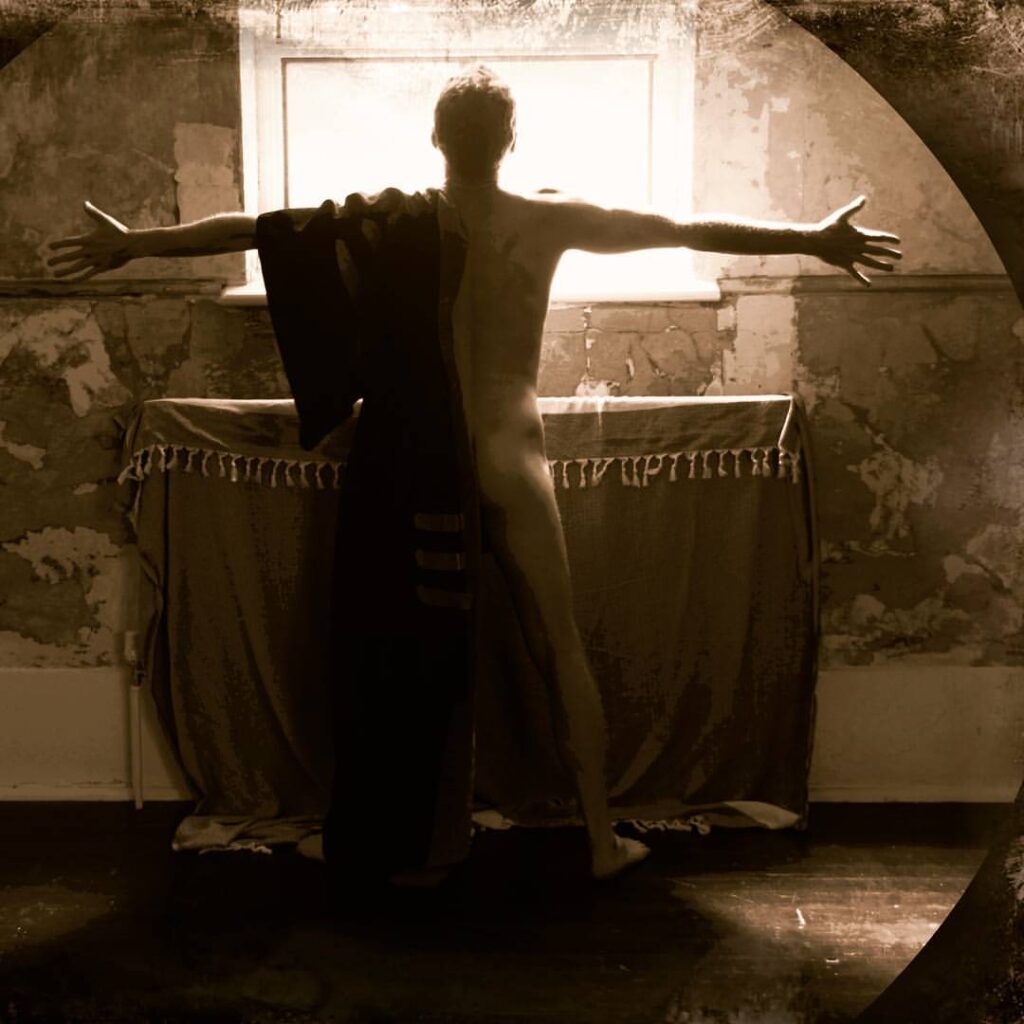
“Morning Worship” by Australia Catholic artist Michael James O’Hanlon
Psalms or verses from psalms might be prayed, such as:
Bless the Lord, O my soul, and all that is within me, bless his holy name (Psalm 103)
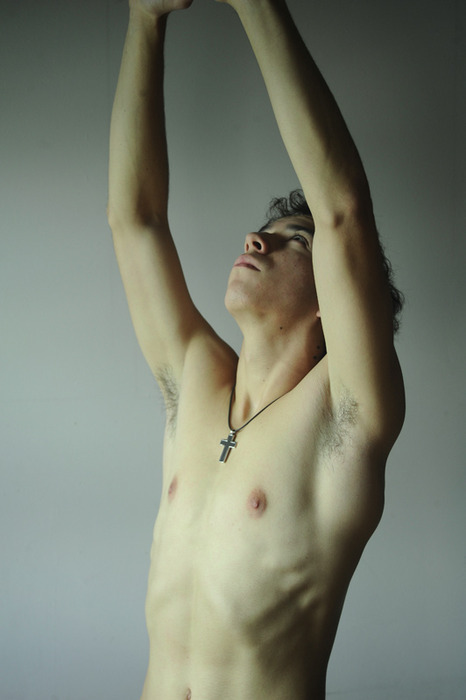
The Benedictus or Song of Zechariah is prayed.


Might nakedness contribute to the enrichment of your spiritual discipline or is it something you are so unused to that it would be a distraction? Could the sheer fact of being naked before God be the focus of your meditation? If you practice meditation or have devotions with a partner (a spouse or a good friend), can you be naked together in the presence of God in Christian fellowship or is this crossing a boundary for you?
This is as far as I’m going to go with this. You will have to try it to discern what it means for you and whether it adds to your prayer life. I can only attest that when I’ve tried it the practice does give me a sense of both vulnerability and openness, and both of those feelings are of great spiritual value. I’d be happy to receive comments from any who have practiced actual nakedness before God. These can be posted in the comments section below this article.
Pastor Frank Senn


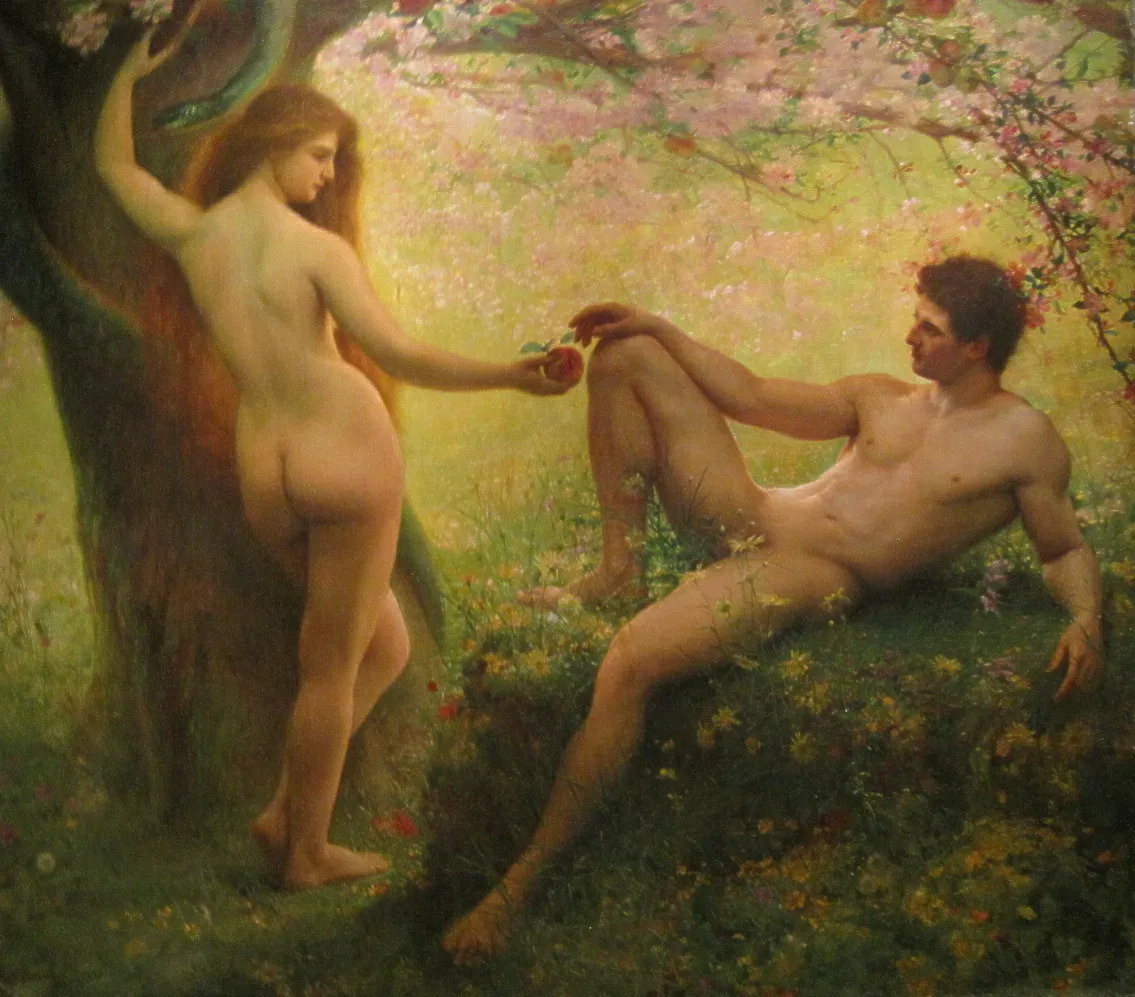


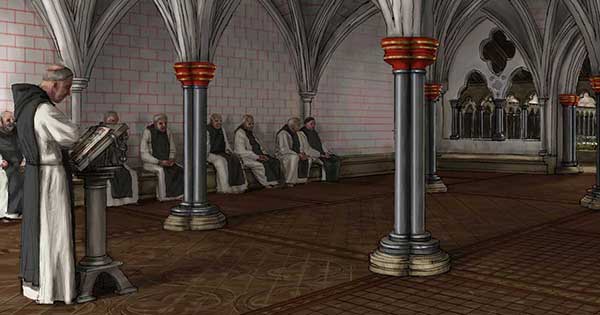

Glen
I’m from a Native American tribe and yes, we do believe in God and we pray to Him when we go into a sweatlodge naked. We are gender separate at these ceremonies and I grew up with this practice and have always felt comfortable being nude with my male friends and relatives. We view this as a way of being humble before God. To us, being naked is truly equivalent to being honest– we have nothing to hide, literally. No one ever seems to be embarrassed or inhibited at the communal nudity we share.